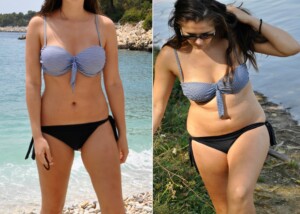
Have your HIIT workouts lost steam at causing weight loss, and now you’re stuck in the mud in a plateau, unable to budge off more fat?
So here you are, watching those pounds drop, and then suddenly … the weight loss stops. What happened?
Is weight loss supposed to stop at some point while sticking to a HIIT program?
If your weight loss has stopped, despite you sticking faithfully to HIIT two or three times a week, you must evaluate other things you’re doing that have interrupted your weight loss efforts.
When a person who wishes to shed pounds starts a HIIT program, the weight will start coming off, and often, quite noticeably.
Introduction of HIIT to a person’s lifestyle creates a metabolic jolt, and the result is more fat-burning than ever before.
This will happen, even if the person has poor eating habits, because high intensity interval training creates such a shock to the body, that the body responds by burning up fat at an unprecedented rate.
However, poor eating habits may get in the way of this eventually. You’re either overeating, or … under-eating.
If you’re overeating, simply shrink the portions or cut down or out the junk food.

Freepik.com,/schantalao
If you’re under-eating, this calorie restriction has lost its ability to sustain your hardcore interval workouts.
Initially, the reduced food intake was able to support your new HIIT program.
But there comes a point where the body just says, “Gee, I need more fuel to keep this up. I can’t let any more fat get melted away. I must hold onto fat reserves for energy.”
The result is that your weight loss has stopped, even though the HIIT goes on.
- Are you letting long periods of time go by between eating? This can slow metabolism and interfere with weight loss plans.
- Is your daily calorie intake too low for all of your physical activity? If it is, the body will fight back by putting a halt on weight loss, to conserve stored body fat for fuel that the body is not getting from food.
Increase your food intake by 5-10 percent and see if this doesn’t jumpstart weight loss, but continue doing HIIT. Never go more than three hours between eating.
If under- or overeating don’t apply to you, or if changing your eating habits doesn’t solve the problem, then re-evaluate your high intensity interval training program.
Is it always on the same cardio equipment? If so, switch up the equipment. If it’s done outside, replace some outside workouts with cardio equipment.

Shutterstock/Maksym Poriechkin
Perhaps your body has adapted to using the same cardio mode over and over for high intensity interval training.
Also see if lately you’ve been slacking on your strength training. Maybe you’ve been going light on the strength training, figuring that the HIIT will take care of all the weight loss.
Beef up other areas of your training. Finally, maybe you’re not pushing as hard as you used to with your intensity intervals. Are you truly going at it with full power, full speed, full throttle?
Make any number of these adjustments if your weight loss has stopped amid consistent HIIT workouts, and your progress should resume.
 Lorra Garrick is a former personal trainer certified through the American Council on Exercise. At Bally Total Fitness she trained women and men of all ages for fat loss, muscle building, fitness and improved health.
Lorra Garrick is a former personal trainer certified through the American Council on Exercise. At Bally Total Fitness she trained women and men of all ages for fat loss, muscle building, fitness and improved health.
.









































